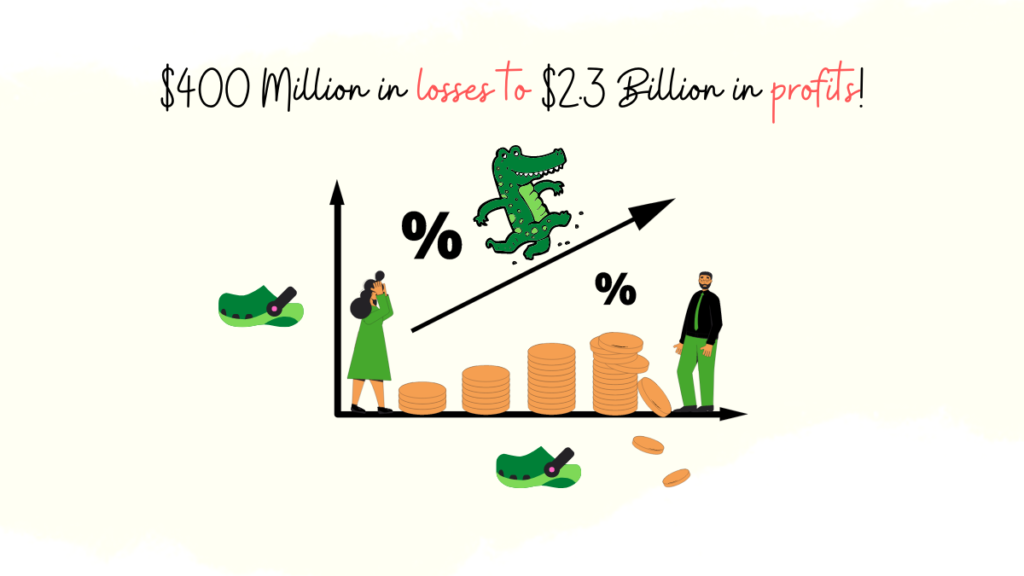From a $400 Million Loss to $2.3 Billion in Profits – A Powerful Story of Marketing Genius
From mountains of shoes and no one to buy them to conquering the mountain to reach the zenith of all profit records, Crocs has aced their branding, positioning, and marketing strategy.
How did this brand that people either love with all they’ve got or absolutely hate transform from being a forgotten, unwanted footwear company to “Special editions all sold out in two hours”?
And how did they achieve that in the pandemic – when businesses were collapsing, the market barely saw any money being pumped into it and the economy took such a beating?
Let’s go back a bit and understand how the brand was born and what it’s evolved into today.
Walking in Their Shoes – Understanding Crocs
When three friends bought the idea from the original producer of these foam shoes, they did so to make them, especially for yachtsmen. The fact that they were light, comfortable, sanitary, airy, and non-absorbent of smells made them an ideal choice for men at sea. Slowly but surely, Crocs (short for Crocodile because the classic Crocs resemble the reptiles they’re eponymous with) became popular among people on land who cared more for comfort than style.
But, for all the people who loved them for their simplicity and comfort, there was a bigger chunk of people who detested them for being plain boring and ugly. The hate is real, by the way, and the community is very vocal about it. Blogs and websites mushroomed so much that they became a cultural phenomenon. In fact, the website Ihatecrocs.com chronicles its proprietors’ attempts to physically destroy Crocs (using things like fireworks, scissors, and lighter fluid).
It was when Crocs stepped out of its niche market and began to try and popularize the humble clog among the masses that it began losing its foothold (pun absolutely not intended) and its allure. In 2006, the brand repositioned itself as an ‘eco-friendly, super basic, useful to the masses’ product. But people were tired of its ‘same, old, boring design and style’. Sales tanked so much that it called for a complete overhaul of the company, what it stood for, and how it positioned itself.
Crocs – The Pop Culture Phenomenon
The turnaround began in 2017, when Andrew Rees took over as CEO and decided to go back to basics. Under his leadership, the brand went back to reposition itself in the market emphasizing on the simplicity and comfort of the signature Crocs clog by shifting focus to “clog relevance and sandal awareness.”
But how did this repositioning strategy get Crocs to go from a modest shoe for a niche market into an explosive pop culture phenomenon almost as a resurrection from the dead?
Before we delve into their marketing strategy, let’s understand how Crocs slowly but surely laid its ground before it went 💥Boom!
#1 – They ‘Owned’ It
“Come as you are” – The brand walks the talk (pun not intended) when it comes to its by-line. Unafraid of being called out as ugly, the brand thrives on the philosophy of – ‘Be Unashamedly You’. Looking back at the history of Crocs, it becomes abundantly clear that despite all the lows they went through, the brand never looked to change its product. It has consistently worked on making it a more personal experience for the wearer. Love it or hate it, you will always have an opinion about it. And we know that when things are talked about, there is no better advertisement.
#2 – They Identified a New Target Market
Crocs was born in the early 2000s, much like its new target market. Perhaps that’s one of the reasons the brand found it easy to target the millennial, Gen-Z market and make its presence re-felt. I think it worked in its favor also because it is these millennials who grew up wearing the OG Crocs, and rediscovering them at a time when they’re able to own it themselves is a sweet hit of nostalgia, that Crocs has capitalized on.
When we delve a little deeper into marketing strategy, it is quite evident that Crocs ‘gets’ millennials. The growth that it’s shown is a testament to that fact. Crocs claim to be a democratic brand that caters to everybody, but they have an admittedly soft spot for the millennial. They say:
…our target consumer is the female millennial, partially because her attributes align to ours. She’s fun. And she’s brave. She’s comfortable in her own shoes, and she’s unapologetically optimistic.
There’s quite a lesson to be learned here – Instead of modifying their product to suit a particular audience, Crocs identified a target customer that echoes its core values.
#3 – They Created a Marketing Strategy Specific to the Said Target Market
We have defined consumer segments, and our younger ‘explorer’ consumer has played an increasingly important role in shaping our global product and marketing strategies. We know they’re active and independent, and most importantly, they want to be able to express their own personal style with their favorite brands.
Terence Reilly, CMO of Crocs.
Once the target market was identified, a quick persona study was the logical next step to craft a marketing strategy that would work best for the market. Let’s break down the Gen-Z persona to understand the specific marketing strategy Crocs crafted.
The Crocs comeback is largely thanks to the brand targeting this segment of consumers, and being quick, diligent and accurate in their understanding of who these Gen-Zers are and what makes them tick. Details of how the brand nailed it with Gen-Zers are discussed in further sections.
#4 – They Stepped Up When it Mattered
When the world was reeling from the pandemic and frontline workers were spending days on end on their feet, Crocs launched the “Free Pair for Healthcare” campaign. Originally set up to give out 10,000 shoes per day to frontline healthcare workers, Crocs later announced that they had ramped up their giveaway and would not give out 20,000 pairs of shoes a day. The campaign ended up giving out 860,000+ pairs of shoes by the end of it – all through its website. At a time when the world was confined to their homes with their screens being their windows to the world, this deed of kindness turned into a fantastic ad campaign for Crocs. After all, who doesn’t like the good guy, right
Pro tip: If you need 30 standout SaaS growth hacks to attain double the growth for your SaaS business, fill out the form below!
The GenZ Marketing Genius | What Was It?
With the re-positioning of the brand and a shift in focus, it was only natural that the marketing strategy had to evolve. The brand was quick to understand that most of its sales were happening online and as a result it chose to shut down 170 stores. Most people buying Crocs online were millennials. And the best way to reach them was digitally.
Side Note: Did you know that the Crocs millennial Gen-Z fanbase has a name? They’re called CrocNation
Recognizing the power and reach of the internet and online market, developing a digital first marketing strategy was but natural.
We needed to spend more as a brand to ignite our customer base and maintain strong connectivity — and architect a marketing strategy that was more effective at getting in front of consumers.
The CEO identifies three things that they did when building their marketing strategy:
#1 – They went all digital
We’re a digital first brand. We’ve been a digital-first brand for years now. And that gave us a lot of momentum through the pandemic to make sure we were meeting customers where they were spending their time. And we also created some fun, you know, we gave away free shoes to healthcare heroes, but we also dropped collaborations and Snapchat filters and other ways to engage our fans as their worlds were changing as well.
Heidi Cooley, Head of Global Marketing, Crocs
Crocs hit the nail on the head with identifying the social media network that most of its target market engaged with – TikTok. 60% of its 1 billion users are Gen-Zers. And it provided the perfect platform for organic searches.
The kind of content they created on TikTok was Flicker Content, Flash Content and Flare Content. Most of this content was organic, user generated and hugely viral.
Flicker Content is when users hop on the challenge bandwagon and become part of what almost seems like a movement. It’s reactive, it’s very frequent and as a result it’s woke. For instance, Crocs roped in the healthcare professionals they’d run the ‘Free Pair for Healthcare’ campaign for, to do a dance challenge in Crocs.
Flash Content is more proactive, less frequent and usually is rolled out in a consistent format with some effort by the brand. For instance, Crocs highlights its collaborations with visual storylines.
Flare Content consists of large scale campaigns that are run maybe a couple of times a year. They’re designed to be engaging, catchy, and rely on a well thought out hashtag (usually) to make it big. For instance, #StrapBack – A campaign Crocs ran with Afterpay.
#2 – They partnered with key global ambassadors
The way I look at collaborations is it’s very wonky math; one plus one equals three. What I mean by that is when you pair a brand like Crocs with another partner — it could be an individual like a Post Malone; it could be a really quirky, distinctive brand, like KFC; it could be an uber-high-end fashion brand like Balenciaga. But when you bring two entities together, and you do something really interesting and fun — the consumer wins. It’s so much more than one plus one.
Michelle Poole, Company President
Collaborations are as old as the earth. But successful collaborations need the right people to be brought together for magic to be created. That is a science and art. The team at Crocs studied mountains of data to identify the right collaborators for their campaigns. Studies revealed an overlap between some influencers and wearers of Crocs. But where Crocs aced their game of choice was in identifying those celebrities that were genuine fans of the shoes. In doing so, they lent their programs an air of originality, authenticity and relatability.
It came as no surprise then that the shoes rolled out in collaboration with Post Malone sold out in a matter of hours.
#3 – They used a brand roster of local influencers in each market
Through their history, Crocs went through a time when they tried to portray themselves as a luxury brand. And in doing so, they used “high-end” influencers – actresses like Drew Barrymore, and even Priyanka Chopra. With their new marketing strategy, they now recognize the influence that micro-influencers have on their target markets. And they’ve used this to their advantage. Identifying influencers from various geographies and collaborating with not necessarily world famous influencers but local stars has sky-rocketed their social presence and their sales.
…we’ve also now evolved to really focus on a tapestry of micro-influencers. Some of these influences have such dedicated followers; they might have a smaller number of followers, but they have a really devoted — almost obsessed — group of followers. So we think about our influencer strategy as a rich tapestry of interests and affinities and geographies — and we stitch it together like a quilt.
Key Lessons From This Massive Turnaround
- If your target market is young, wild and free, a little hype goes a long way! FOMO is a rather effective driver in influencing buying decisions. Nothing about their product changed. Just the way they sold it.
- Offer personalization. The Crocs acquisition of Jibbitz all those years ago has made it possible for them today to revolutionize Crocs into arguably the most personalize-able shoes ever made. Every pair of Crocs has been turned into a blank canvas that the wearer can make a one of a kind, unique piece, stamped with its individual style.
- Developing a communication strategy that echoes your brand sentiment and helps you connect with your audience is key. Crocs uses short, snappy, yet conversational communication in all its social media marketing. With short attention spans and so much content to consume, it feels like they’ve cracked the recipe for success.
- Choosing the right platform to engage with your market is vital. Not only did Crocs go digital, they staggered their marketing ideas across various platforms designing campaigns around their USPs. For instance, they chose to release filters on Snapchat and encouraged video challenges on TikTok. Had they chosen to do those things in reverse, the campaigns wouldn’t likely be as effective or successful.
- Choose honest collaborations. Every collaborative campaign that Crocs entered into – whether it was Post Malone or Justin Bieber, KISS or The Grateful Dead, Balenciaga or KFC – was honest, real and raw. In doing so, they struck a chord with every buyer making every collaboration feel unmissable.
- You don’t need to pressure generate content. Let the user do it for you. With its Flicker and Flash content strategies, Crocs garnered tens of thousands of followers, a quadruple increase in sales and their name all over social media. If that’s not every marketer’s dream, I don’t know what is!
On the same note, LEGO’s success story is also quite inspirational. From $800 million in Debt they turned into a powerful brand with $600 million in profit. Thanks for reading the story. Stay inspired!
If your organisation wants to elevate its content marketing strategy, one designed by Concurate, let’s connect over a short call. Block our calendar today!
If you wish to read more goodness, subscribe to our newsletter.
We send value to your inbox only once in 15 days.






